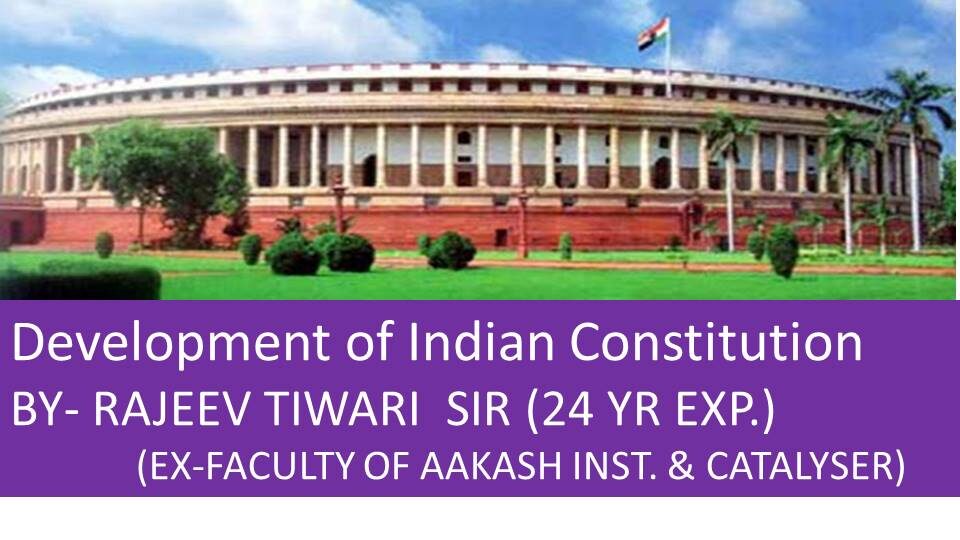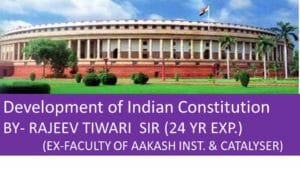Brief History of the Development of Indian Constitution.
* After the Victory of Plassey in 1757and Buxur in 1764 by the
British army, Bengal administration came
under the East India Company.
* To keep Bengal administration in their favour, the British enacted
many Acts which later became the
foundation of the Indian Constitution. MODERN HISTORY FACTS
* The Regulating Act of 1773–
It laid the foundation of a government in Calcutta presidency in which a
council of the Governor-general established consisting of 4
members. They exercised their powers
jointly. The main features of this Act are-
- Parliamentary control over the government of the company.
- Governor of Bengal made the Governor-General of Bengal.
- A Supreme Court established at Fort William
- Subordination of the Presidencies of Bombay and Madras to that of Bengal.
Brief History of the Development of Indian Constitution
Pitt’s India Act, 1784- SIKH RELIGION – IMPORTANT FACTS
* Established Court of Directors for trade affairs
* Also established Board of Control for Political affairs.
* It reduced the number of members of the Governor-General in council from 4 to 3
- Charter Act of 1793:
* It Provided that the member of Home Govt. (a member of Board
of control and Employees) were in the future
to be paid salaries from the Indian revenues and not from British Exchequer.
- Charter Act of 1813:
* It renewed the company’s charter for a further period of 20 years
* It abolished the monopoly of the company’s Indian trade and
threw open to all British subjects under certain regulations.
* But its monopoly of trade with China and trade in tea with eastern countries was retained
- Charter Act of 1833:
* Complete abolition of company’s monopoly over trade
* It reduced the company from a governing body to a mere administrative body of British Govt.
* Governor-General of Bengal made Governor-General of India.
* A Law commission was constituted for consolidating, codifying and improving Indian laws.
- Charter Act of 1853:
* Strength of the Court of Directors reduced
* The law member became the full member of the Governor-
General in Council.
* This was the last charter Act.
- Act of 1858:RISE OF BUDDHISM
* Indian administration had taken over by British crown.
* Portfolio system was introduced in India.
* A council of 15 members, known as the council of India, was created.
* System of double government (introduced by Pitt’s India Act, 1784) finally abolished
* Indian administration came under direct control of the British crown.
- Indian Council Act, 1861:
* Governor General’s Executive Council expanded
* Portfolio-system was introduced.
* Governor-General was empowered to issue ordinance in time of an emergency.
* Governor-General was empowered to establish legislative councils
for Bengal, Northern-Western
Frontier Province and Punjab.WORLD HEALTH ORGANIZATION DISPUTE
- Indian Council Act, 1892:
* Beginning of Parliamentary system as this Act allowed discussion over budget and quarries by members.
* Council members granted right to ask the question.
- Indian Council Act, 1909(Morley – Minto Reforms)
* First-time separate electorate for Muslims introduced.
* One Indian was to be appointed to the viceroy’s executive council
and Satyanarayan Singh became the first Indian to be appointed to
the council in 1909.
* Powers of Legislatures were enlarged allowing them to pass resolutions, ask questions and
supplementaries , vote on separate items in the budget but budget as a whole could not be voted upon.
* No of elected members increased in Legislative councils
- The Govt. of India Act, 1919 (Montague – Chelmsford Reforms):
* The central legislature council made bicameral i.e. legislative
Assembly and council of states.
* The No. of the member in the council of states was 60 and
out of the 34 were elected for a five-year term.
* 145 members were the strength of Legislative Assembly and
out of the 104 were elected and 41 were nominated for 3 years.
Both House were given equal rights.
* The only difference was that the lower house had the power to pass the budget.
* The Act introduced ‘Dyarchy’ in the provinces which provided for
the division of provincial subjects
into “ Reserved” and “ Transferred” categories.
Reserved Subject – Finance, land-tax, feminine help, justice,
police, pension, criminals, Newspaper, Irrigation, Mines, waterway,
factories, electricity, gas, labor – welfare, industrial disputes, Motor-vehicles, miner port, and public services, etc.
Transferred Subject: Education, library, Museum, local self-
government, Health, Public building department, excise, weight
and measurement, industry, control over public entertainment, religion, etc.
Government of India Act, 1935:
* Abolition of Dyarchy
* Secretary of state for India was empowered to appoint comptroller and Auditor-General in India.
* Provided the Provision to establish a Public Service Commission in India.
* There were 451 Acts & 15 annexes in Act.
* This Act made the provisions for an all India federation consisting of eleven British Provinces, six chief
commissioner’s areas, and those princely states which desired to be the part of the federation.
* At the provincial level ‘autonomy’ replaced dyarchy and responsible government was introduced.
Dyarchy at the center level: Glossary of Geography
- Some Union subjects (Security, Foreign affairs, Religious matters) were vested in Governor-general. For
other union subjects, a council of ministers was set up.
Establishment of Federal Court:
* Its Jurisdiction was extended to provinces and princely states
there was chief justice and two other judges in the court
* Privy council (London ) has the supreme power of Judiciary
The supremacy of the British Parliament:
* This Act could be amended by the British parliament. Only the
British Parliament was empowered to amend
This Act.
- This Act abolished the Council of State for India.
- Communal Election Pattern expanded.
* Communal electorate system continued for different communities
at the center and provincial level and it extended to Anglo –
Indians, Indian-Christians, Europeans & Harijans.
* There was no preamble in the Act.
* The Act separated Burma from India and two new states were
created. Adan came under British subordination and Barar mingled
with central Province.
Brief History of the Development of Indian Constitution
Indian Independence Act, 1947: It was proposed on 4th July
1947 in the British Parliament but it was Passed on 18th July 1947.
Main provisions of this Act are as follows-
* It fixed the date of 15th August 1947 for setting up the two
Dominions, namely India and Pakistan. It is
decided to hand over the responsibility of power to the constituent
assemblies of the dominion states.
* There would be separate Governor-General for each Dominion (India &Pakistan)
* The Act also laid down temporary provision for the government of
the dominions by giving the status of Parliament with the full
power of the Dominion legislature to both the constituent
Assemblies.
* The Act further mentioned that till the new constitutions are not
effective, the governments in the two states will be run on the basis
of provisions of the GOI Act, 1935
* Sovereignty and responsibility of the British Parliament abolished.
* Pakistan was to comprise East Bengal, West Punjab, Sind, and the Sylhet district of Assam.



Pingback: TRICK- भारत के राष्ट्रपति क्रमानुसार - Gour Institute
Pingback: SPECIAL GS FOR COMPETITIVE EXAMS - Gour Institute
Pingback: GK TODAY IN HINDI - Gour Institute
Pingback: TRICK- PRESIDENTS OF INDIA LIST - Gour Institute